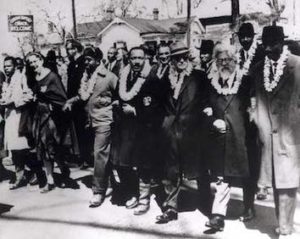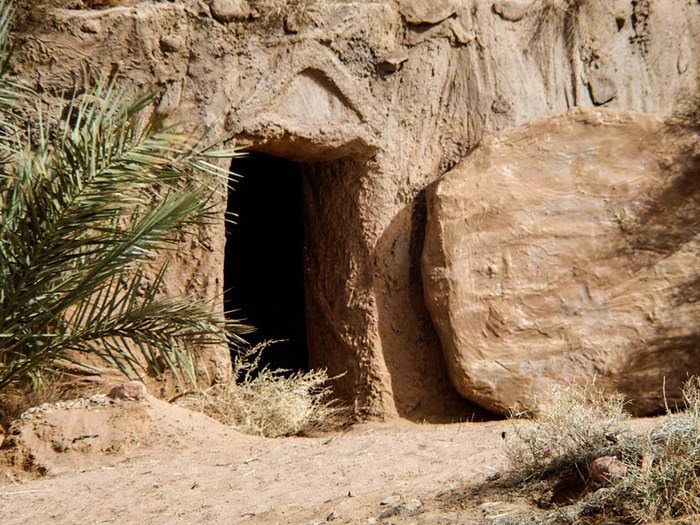Easter establishes its own context as it represents the culmination of the Christian story, and in that regard presents a particular challenge to any preacher. It is the day that asks the most from any of us who would mount a pulpit. The notion of Jesus’ resurrection is the coda or sequel if you will, using a notion that is well understood today from the world of movies, that changed the whole plot line. What seemed to come to a conclusion on Good Friday with Jesus’ death on the cross was upended by Jesus’ resurrection on Easter Sunday. That event functioned as a game changer, a surprise ending if you will.
Of course, there is always the question of whether that ending is plausible, or in fact a trick or gimmick.
The Details Are Not the Point
 Explaining the resurrection is the first and most arduous task for the preacher on Easter. The easy, but I think, facile way to deal with the matter is to let it all present as a literal phenomenon, with Jesus walking out of the tomb as any of us walked into this room today.
Explaining the resurrection is the first and most arduous task for the preacher on Easter. The easy, but I think, facile way to deal with the matter is to let it all present as a literal phenomenon, with Jesus walking out of the tomb as any of us walked into this room today.
What always perplexes me in that regard is the way the resurrection stories portray Jesus as simply gone, or in the Gospel of John, he is not immediately recognized. That suggests to me that the literal suggestion that Jesus, like Boris Karloff in the first Mummy film from the 1930s, just stirred and then rose up and staggered out of the crypt, is misguided.
What I’ve always taken the substance of the resurrection story to be about how the women first, and then the disciples and others, became aware of the presence or spirit of Jesus which somehow made itself felt in their midst. It was not necessarily his corporeal self that appeared before him.
I don’t really need to know the details of what prompted that perception. It is enough for me to know that something happened that awakened the hearts and souls of the women and disciples in such a way that they felt that Jesus had returned to them.
If, by way of comparison, I see only the part of a fly ball land in a baseball field, I don’t have to see the hitter or pitcher or the thrower to know that ball was sent flying at someone’s behest. Likewise, it is enough for me to know that those witnesses experienced something. The specifics of their experience are lost to me, but the consequences for them were profound and life changing, and therefore I accept them as unquestionably real and authentic.
So, going from that starting point, there is a question that follows: Is that same spirit or presence of Jesus that so moved the women and disciples still about in our world, and is it accessible to us today?
The answer on both counts in my perception is yes, although coming to understand where and how Jesus is manifest in our world may entail some adjustment of our expectations and preconceptions. We may need to reframe or reform our thinking; in biblical imagery we may need to throw away the old wines skins and replace them with new, to unearth Jesus in a contemporary setting. We are not necessarily going to come upon him with long flowing hair, in a robe, or wearing sandals. Our central casting vision of Jesus may need to change.
Let me offer an illustration of what I mean.
Easter as an “Ah, Ha!” Moment
When I first began my time in ministry, I worked with a youth group that spent a lot of time just hanging out in my office. We would sit around and talk about all manner of subjects, some directly related to church and religion and some just what was on the kids’ minds.

Those were the days when potato chip and coke communion was a novelty, much like we had one year at Pakachoag Church, Pine Sunday rather than Palm Sunday. I suggested to the kids an understanding of communion as a communal experience in which we participated in a shared moment that brought us closer to one another and to an understanding of the original meal Jesus shared with his disciples. I emphasized that we didn’t necessarily have to be arrayed around a table with a linen cloth draped over it and in the chancel of church to have an authentic experience.
It came clear to me one day that that message had gotten through when the youth group was sharing in a progressive meal. As we sat around a dining room table in a family’s home, one person, Cindy, picked up an apple, took a bite, and said, “Communion!” She then passed the apple to the next person who realized what Cindy meant and immediately took a bite and handed the apple on. It went around the table, and we all took a bite. I knew then that those young people had moved with me in their conception of what communion was all about.
I think the experience for the women at the tomb was that same kind of burst of awareness, an “ah, ha!” moment. They knew Jesus one way, but were able to recognize him in another manifestation.
Finding Jesus in our World
The first step in finding Jesus as he is manifest in our world comes with remembering where he took himself in his ministry and with whom he stood. In all instances, Jesus’s first attachments and sympathies were to those who were
disenfranchised from society. He advocated for women, for the leper, for the widow, for the outcast, for the poor, for the stranger. Jesus understood that his mandate of compassion came from God and that if he was to follow God’s will most faithfully that he, Jesus, must dedicate himself to supporting others, especially others who were in some way deprived.
The fire at Notre Dame Cathedral in Paris this week solicited a worldwide, communal outpouring of grief and dismay that was boundless. The measure of that tragedy was felt by all, essentially without exception. I believe the spirit of God looks out upon this world and sees the many lives that are aflame with all kinds of distress raging within and around them, and grieves for them as all of us grieved for Notre Dame Cathedral. The spirit of God stands alongside the wounded, the disenfranchised, those discriminated against, the frail, the outcast, the poor, and yearns that they might receive a measure of aid and comfort as abundant as that which came forward for the wounded Notre Dame Cathedral.
Similarly, it is that where there is someone tending to human need, there is Jesus — and if we are looking to encounter him, then we need look no further than in the deeds and gestures of the caretakers of this world.
At its fullest expression, however, the call to be a faithful follower is extremely demanding. It requires full and unrestrained commitment and unwavering expression.
An Achievable Level of Faith
The truth (and it is one reality certainly preachers know) is that the average person in the pew is just not ready to embrace his/her Christianity to an ultimate degree. Nor is it likely either that even the minister is prepared to go the full measure. None of us is readily willing to sell all we have, as scripture calls us to do, and give it to the poor,
turning our lives over to the service of others. There are very few who are imbued with the spiritual fervor of Mother Theresa and the discipline to commitment ourselves without restraint to the care of the poor and downtrodden.
So, the question for an honest preacher and an honest body of believers lies in finding our way to a committed level of faith expression that is both of a meaningful measure and at the same time achievable to a reasonable degree.
How do we become as Jesus to others in the context of the kind of daily life that has us all struggling to provide for ourselves and our families’ needs, meet the obligations of work and other commitments, be kind to friends and neighbors, and still come up with an extra measure of compassion and understanding for others in this world who may be floundering or otherwise beset?
I think the possibilities are there simply in the conscious exercise of acts of good will, especially those that acknowledge the worth of every human being no matter their circumstances or position.
Everyday Easter Stories
A woman whom I have known all my life, or more appropriately who has known me all my life, died this week at 96. My sister remembered in a note to her son how kind Helen was at the time of our father’s death – 50 years ago. Now, in her time of death, my sister offered back the same gesture to this woman’s son in a letter my sister penned. I believe Jesus’s spirit showed itself fifty years ago in Helen’s thoughtful presence to my family in a time of loss, and showed itself again these five decades hence in these shared expressions of caring. To the extent that we can offer comfort to the bereft, we invoke and make visible the spirit of a risen Jesus.
My brother, who has been struggling with a number of health issues, mentioned to me that recently he was resting on a hospital bench looking down when two men came up to him expressing concern and asking if he needed assistance. When he looked up, he observed that both of them were standing on artificial legs, the springy kind he described it, and surmised they were wounded veterans, something which especially resonated with him because he himself is a Vietnam Vet. He said he immediately threw off his sense of personal hardship and self-indulgence at feeling weak and sick himself, becoming keenly conscious in the moment of how those two men, so much more burdened than he was, were moved to offer another person aid. I posit the spirit of the risen Christ was present in that moment.
I came upon an article this week about a Boston Marathon runner who took on that race in memory of three of his fallen comrades. This runner, Micah Herndon, made the news because he was competing on behalf of those three men whom he knew while he served as a Marine in Afghanistan. He told his local newspaper, the Record-Courier, Portage County, Ohio, “that whenever he feels like giving up he just repeats their names: Mark Juarez, Matthew Ballard and Rupert Hamer.” He had to crawl across the finish line on his hands and knees and in the end be lifted into a wheelchair, but he met his goal. I posit the spirit of the Risen Jesus stood alongside Micah Herndon as he was lifted into that wheelchair at the finish line of the Boston Marathon.

There was a renowned Jewish scholar of a generation ago whose name was Abraham Heschel. I read his writings while I was in Seminary. He was what in today’s idiom would be labeled an activist. His understanding was that faith was not something simply to be approached as an idea or debated for its fine points, but something to be lived and expressed in everyday life. He was present to the Black Civil Rights Movement of the 1960s and participated in the famous march in Selma, Alabama in 1965, at which event he said he felt his feet were praying as he walked on behalf of Civil Rights. The spirit of the Risen Christ I believe stood alongside Abraham Heschel that day.
Easter’s Living Legacy
Tombs are dark, dank, moldy, oxygen starved, places. They are intended for the dead, not the living. The spirit of Jesus escaped that setting and came to life again within and among those who had known him in life, and those generations on, right up to our generation, who through the repeated witness of the faithful through deeds of loving kindness and gestures of an open spirit would come to know him.
The story of Easter is about life and about a better life for all through the spirit of Jesus as it is made manifest among and within all of us. The story of Easter is about praying with our feet, with our hands, and with our hearts. It is in that way that Jesus lives on.

